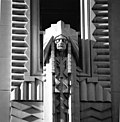

Rogers and MacFarlane was an architectural firm based in Detroit, Michigan, founded in 1885 by James S. Rogers and Walter MacFarlane. The firm produced commissions in Detroit and southern Michigan from 1885 until 1912.
Contents
James S. Rogers (born in Alexandria, Virginia, December 5, 1859) was the son of James S. and Virginia (Leef) Rogers. He was educated in the public schools of Baltimore, Maryland, and attended Baltimore City College, and Massachusetts Institute of Technology. He married Eleanore White at Adamstown, Maryland, in June, 1895. He was the co-founder of the firm of Rogers & MacFarlane, then later Rogers & Bonnah, with offices at 1330 Penobscot Building in Detroit. He resided at 183 Seminole Avenue, Detroit, Michigan. [1]
Walter MacFarlane (born in Cold Spring, New York, June 15, 1859) attended Detroit Public Schools, and was a student at West Point, although he was not college–trained in architecture. He was first employed in the architect's office of Mr. Lloyd in Detroit. Later, he co-founded Rogers & MacFarlane, which maintained offices in Detroit for almost thirty years. MacFarlane left the firm in 1910 after suffering a nervous breakdown. After resting in Colorado and Arizona, he returned to Detroit in 1912 and formed a partnership with Walter Maul and Walter Lenz, architectural graduates of the University of Michigan (MacFarlane, Maul, and Lentz). MacFarlane married Mildred A. Griffin of New York October 14, 1914, in South Orange, New Jersey. He lived at 1053 Iroquois Avenue, Detroit, Michigan, until he died December 16, 1919. [2]
Rogers and MacFarlane were responsible for the design of many of the office buildings, banks and factories of Detroit, including the Morgan & Wright Bicycle Tire Company plant (later Uniroyal), the Cadillac Motor Works, the Murphy Power Plant on Congress Street (purchased by Detroit Edison June, 1914), [3] the King's China Store (L. B. King and Company Building), and a large number of the most beautiful homes in Detroit. [2]






